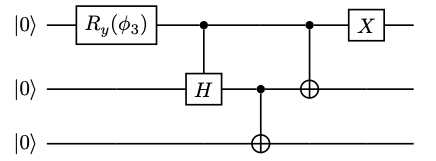W state on:
[Wikipedia]
[Google]
[Amazon]
The W state is an entangled
 The W state is the representative of one of the two non-biseparable classes of three-qubit states, the other being the Greenberger–Horne–Zeilinger state, , which cannot be transformed (not even probabilistically) into each other by local quantum operations. Thus and represent two very different kinds of tripartite entanglement.
This difference is, for example, illustrated by the following interesting property of the W state: if one of the three qubits is lost, the state of the remaining 2-qubit system is still entangled. This robustness of W-type entanglement contrasts strongly with the GHZ state, which is fully separable after loss of one qubit.
The states in the W class can be distinguished from all other 3-qubit states by means of multipartite entanglement measures. In particular, W states have non-zero entanglement across any bipartition, while the 3-tangle vanishes, which is also non-zero for GHZ-type states.
The W state is the representative of one of the two non-biseparable classes of three-qubit states, the other being the Greenberger–Horne–Zeilinger state, , which cannot be transformed (not even probabilistically) into each other by local quantum operations. Thus and represent two very different kinds of tripartite entanglement.
This difference is, for example, illustrated by the following interesting property of the W state: if one of the three qubits is lost, the state of the remaining 2-qubit system is still entangled. This robustness of W-type entanglement contrasts strongly with the GHZ state, which is fully separable after loss of one qubit.
The states in the W class can be distinguished from all other 3-qubit states by means of multipartite entanglement measures. In particular, W states have non-zero entanglement across any bipartition, while the 3-tangle vanishes, which is also non-zero for GHZ-type states.
quantum state
In quantum physics, a quantum state is a mathematical entity that provides a probability distribution for the outcomes of each possible measurement on a system. Knowledge of the quantum state together with the rules for the system's evolution i ...
of three qubits
In quantum computing, a qubit () or quantum bit is a basic unit of quantum information—the quantum version of the classic binary bit physically realized with a two-state device. A qubit is a two-state (or two-level) quantum-mechanical system, ...
which in the bra-ket notation has the following shape
:
and which is remarkable for representing a specific type of multipartite entanglement and for occurring in several applications in quantum information theory
Quantum information is the information of the quantum state, state of a quantum system. It is the basic entity of study in quantum information theory, and can be manipulated using quantum information processing techniques. Quantum information re ...
. Particles prepared in this state reproduce the properties of Bell's theorem, which states that no classical theory of local hidden variables can produce the predictions of quantum mechanics. The state is named after Wolfgang Dür, who first reported the state together with Guifré Vidal
Guifré Vidal is a Spanish physicist who is working on quantum many-body physics using analytical and numerical techniques. In particular, he is one of the leading experts of tensor network state implementations such as time-evolving block deci ...
, and Ignacio Cirac in 2002.
Properties
 The W state is the representative of one of the two non-biseparable classes of three-qubit states, the other being the Greenberger–Horne–Zeilinger state, , which cannot be transformed (not even probabilistically) into each other by local quantum operations. Thus and represent two very different kinds of tripartite entanglement.
This difference is, for example, illustrated by the following interesting property of the W state: if one of the three qubits is lost, the state of the remaining 2-qubit system is still entangled. This robustness of W-type entanglement contrasts strongly with the GHZ state, which is fully separable after loss of one qubit.
The states in the W class can be distinguished from all other 3-qubit states by means of multipartite entanglement measures. In particular, W states have non-zero entanglement across any bipartition, while the 3-tangle vanishes, which is also non-zero for GHZ-type states.
The W state is the representative of one of the two non-biseparable classes of three-qubit states, the other being the Greenberger–Horne–Zeilinger state, , which cannot be transformed (not even probabilistically) into each other by local quantum operations. Thus and represent two very different kinds of tripartite entanglement.
This difference is, for example, illustrated by the following interesting property of the W state: if one of the three qubits is lost, the state of the remaining 2-qubit system is still entangled. This robustness of W-type entanglement contrasts strongly with the GHZ state, which is fully separable after loss of one qubit.
The states in the W class can be distinguished from all other 3-qubit states by means of multipartite entanglement measures. In particular, W states have non-zero entanglement across any bipartition, while the 3-tangle vanishes, which is also non-zero for GHZ-type states.
Generalization
The notion of W state has been generalized for qubits and then refers to the quantum superposition with equal expansion coefficients of all possible pure states in which exactly one of the qubits is in an "excited state" , while all other ones are in the "ground state" : : Both the robustness against particle loss and the LOCC-inequivalence with the (generalized) GHZ state also hold for the -qubit W state.Applications
In systems in which a single qubit is stored in an ensemble of many two-level systems the logical "1" is often represented by the W state, while the logical "0" is represented by the state . Here the W state's robustness against particle loss is a very beneficial property ensuring good storage properties of these ensemble-based quantum memories.See also
* NOON stateReferences
{{DEFAULTSORT:W State Quantum information theory